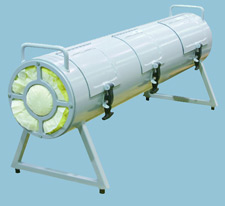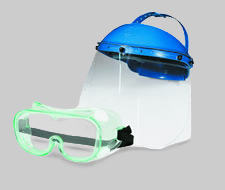Home | Glossary | Resources | Help | Contact Us | Course Map
Archival Notice
This is an archive page that is no longer being updated. It may contain outdated information and links may no longer function as originally intended.
Bullet Recovery
An essential aspect of firearms identification is obtaining known specimens of fired bullets to be used as comparison standards. This is accomplished by firing into an appropriate bullet recovery system (water, cotton waste, etc.).
The following safety rules apply to bullet recovery systems:
- Be certain that the bullet recovery system is appropriate for the type of ammunition being tested. If necessary, download the cartridge using the Association of Firearm and Tool Mark Examiners (AFTE) Protocol.
- Place the muzzle inside the shooting tube prior to chambering a cartridge as a precaution against slam fires.
- Use a face shield when firing to minimize the effects of potential back spatter of metal fragments.
- Use body armor when appropriate to minimize the effects of potential back spatter.
- Load and fire one cartridge at a time to prevent a defective or modified firearm from going into full automatic fire.
Distance Determination
When performing distance determination test firing, special precautions must be taken to ensure safety including the following:
- Keep the firearm and ammunition at the firing line.
- Load and fire one cartridge at a time.
- Fire only towards the bullet trap.
- When marking distances to fire known-distance patterns, do not place hands in front of the firearm. Use a steel measuring tape projecting forward of the muzzle or a hanging string in combination with known distances marked on the floor or ground.
- Vary the orientation of the target rather than the firearm when simulating angled bullet paths.
- Prior to firing, announce your intention to fire.
- Clear the firearm before leaving the firing line.
In the Courtroom
Immediately upon receiving a firearm in court, it must be checked to ensure that it is in a safe condition by
- removing the magazine if it has been re-inserted,
- opening the action,
- checking the chamber visually and manually to ensure it is clear.
This should be performed in the clear view of the judge, jury, and others in the courtroom. When the firearm is determined to be in a safe condition for further handling during testimony, the examiner should lay it on a flat surface with the muzzle of the firearm pointing in a safe direction. At no time should unfired evidence ammunition be opened and accessible when an unsealed firearm is in the courtroom.
Additional Online Courses
- What Every First Responding Officer Should Know About DNA Evidence
- Collecting DNA Evidence at Property Crime Scenes
- DNA – A Prosecutor’s Practice Notebook
- Crime Scene and DNA Basics
- Laboratory Safety Programs
- DNA Amplification
- Population Genetics and Statistics
- Non-STR DNA Markers: SNPs, Y-STRs, LCN and mtDNA
- Firearms Examiner Training
- Forensic DNA Education for Law Enforcement Decisionmakers
- What Every Investigator and Evidence Technician Should Know About DNA Evidence
- Principles of Forensic DNA for Officers of the Court
- Law 101: Legal Guide for the Forensic Expert
- Laboratory Orientation and Testing of Body Fluids and Tissues
- DNA Extraction and Quantitation
- STR Data Analysis and Interpretation
- Communication Skills, Report Writing, and Courtroom Testimony
- Español for Law Enforcement
- Amplified DNA Product Separation for Forensic Analysts



